Evaluating the Attraction of Scenic Spots Based on Tourism Trajectory Entropy
Abstract
1. Introduction
1.1. Post-Evaluation of Attraction
1.2. Outline of the Article
2. Literature Review
2.1. The Destination Attraction
2.2. The Application of GPS in Tourism
2.3. Network Analysis in Tourism
2.4. The Application of Information Entropy
3. Methodology
3.1. Study Area and Data
3.2. Conceptual Framework
3.3. Information Entropy
3.4. Linear Normalization
4. Results
4.1. The Identification of Local Tourists (Lo-Tour) and Visiting Tourists (NLo-Tour)
- (1)
- Among the 125 tourists, 67 were local tourists, and 58 were visiting tourists, with local tourists slightly exceeding visiting tourists.
- (2)
- For tourists that visit zero scenic spots, the trajectory distribution of local and visiting tourists is often more concentrated, which means that most local tourists choose to relax during their rest time and travel around their homes. However, visiting tourists choose to relax and explore the surrounding areas near the hotel.
- (3)
- For tourists that visit a few scenic spots, the trajectories of local tourists are often scattered, while the trajectories of visiting tourists are often concentrated. Considering the familiarity that local tourists have with the area, the visiting range will be larger; on the other hand, visiting tourists will choose hotels with many scenic spots to stay in, and then choose places near these hotels for leisure tourism, leading to a relatively concentrated trajectory distribution.
- (4)
- For tourists that visit many scenic spots, whether local or visiting, there is a relatively scattered trajectory distribution, which is directly related to the number of scenic spots and conforms to a major characteristic of multiple scenic spots.
- (5)
- The concentration and dispersion distribution differences between local tourist trajectories are relatively small. However, for visiting tourists, what is more obvious is that the trajectory of most tourists is concentrated.
- (6)
- In terms of the number of scenic spots visited, local and visiting tourists have the highest proportion of visiting only a few scenic spots, about 60%; followed by non-scenic spot, accounting for more than 20%; and multiple scenic spots, accounting for less than 20%. This indicates that over 20% of tourists choose non-scenic leisure tours.
- (1)
- For local tourists, the Dadonghai Tourist Area, the Coconut Dream Corridor, the Luhuitou Peak Park, and the Yalong Bay Tropical Paradise Forest Park are the most popular scenic spots; Yazhou Ancient City is more likely to be repeatedly visited.
- (2)
- For visiting tourists, the Nanshan Cultural Tourism Zone, the Tianya Haijiao Tourist Area, the Yalong Bay Tropical Paradise Forest Park, the Luhuitou Peak Park, and the Dadonghai Tourist Area are the most popular scenic spots; the Coconut Dream Corridor is more likely to be repeatedly visited.
- (3)
- From the analysis results, it can be seen that local tourists have lower enthusiasm for the Nanshan Cultural Tourism Zone and Tianya Haijiao Tourism Area compared to visiting tourists.
- (4)
- Yazhou Ancient City is a scenic spot that is frequently visited by local tourists but rarely visited by visiting tourists. It is speculated that this is because the scenic spot is not well known to the public.
4.2. Attraction Index of Scenic Spots
4.2.1. Regression Model
4.2.2. Tourism Entropy
4.2.3. Comparative Analysis of Tourism Entropy and Regression Models
4.2.4. Attraction Index Rating of Scenic Spots
- (1)
- Scenic spots with higher A-level generally have higher attraction, meaning that the attraction of scenic spots is significantly influenced by their level.
- (2)
- A-level or above scenic spots will not decrease their attraction due to high ticket prices, which means that the attraction of scenic spots will not be significantly affected by ticket prices.
- (3)
- Due to inconvenient transportation, the attraction of some A-level and above scenic spots has been seriously affected, which means that the attraction of scenic spots is more significantly affected by transportation convenience.
4.3. Tourist Experience Index
4.4. Network Relationship between Scenic Spots
5. Conclusions and Discussion
Author Contributions
Funding
Institutional Review Board Statement
Data Availability Statement
Conflicts of Interest
References
- Pearce, D.G. Towards a geography of tourism. Ann. Tour. Res. 1979, 6, 245–272. [Google Scholar] [CrossRef]
- Formica, S. Destination Attractiveness as a Function of Supply and Demand Interaction. Ph.D. Dissertation, Virginia Polytechnic Institute and State University, Blacksburg, VA, USA, 2000. [Google Scholar]
- Hu, Y.; Ritchie, J.R.B. Measuring Destination scenic spot: A Contextual Approach. J. Travel Res. 1993, 32, 25–34. [Google Scholar]
- Pike, S. Destination image analysis: A review of 142 papers from 1973 to 2000. Tour. Manag. 2002, 23, 541–549. [Google Scholar] [CrossRef]
- Edward, M.; George, B. Tourism development in the state of Kerala, India: A study of destination scenic spot. Eur. J. Tour. Res. 2008, 1, 16–38. [Google Scholar] [CrossRef]
- Ariya, G.; Wishitemi, B.; Sitati, N. Tourism destination scenic spot as perceived by tourists visiting Lake Nakuru National Park, Kenya. Int. J. Res. Tour. Hosp. 2017, 3, 1–13. [Google Scholar]
- Buhalis, D. Marketing the competitive destination of the future. Tour. Manag. 2000, 21, 97–116. [Google Scholar] [CrossRef]
- Dimitrov, P.M.; Stankova, M.Z.; Vasenska, I.; Uzunova, D. Increasing attractiveness and image recognition of Bulgaria as a tourism destination. Tour. Manag. Stud. 2017, 13, 39–47. [Google Scholar] [CrossRef]
- Boivin, M.; Tanguay, G.A. Analysis of the determinants of urban tourism scenic spot: The case of Québec City and Bordeaux. J. Destin. Mark. Manag. 2019, 11, 67–79. [Google Scholar]
- Raimkulov, M.; Juraturgunov, H.; Ahn, Y. Destination scenic spot and memorable travel experiences in silk road tourism in Uzbekistan. Sustainability 2021, 13, 2252. [Google Scholar] [CrossRef]
- Lee, C.F.; Ou, W.M.; Huang, H.I. A study of destination scenic spot through domestic visitors’ perspectives: The case of Taiwan’s hot springs tourism sector. Asia Pac. J. Tour. Res. 2009, 14, 17–38. [Google Scholar] [CrossRef]
- Wu, T.C.; Xie, P.F.; Tsai, M.C. Perceptions of scenic spot for salt heritage tourism: A tourist perspective. Tour. Manag. 2015, 51, 201–209. [Google Scholar] [CrossRef]
- Kim, D.; Perdue, R.R. The influence of image on destination scenic spot. J. Travel Tour. Mark. 2011, 28, 225–239. [Google Scholar] [CrossRef]
- Das, D.; Sharma, S.K.; Mohapatra, P.K.; Sarkar, A. Factors influencing the attractiveness of a tourist destination: A case study. J. Serv. Res. 2007, 7, 103–134. [Google Scholar]
- Lee, C.F. An investigation of factors determining industrial tourism scenic spot. Tour. Hosp. Res. 2016, 16, 184–197. [Google Scholar] [CrossRef]
- Islam, S.; Hossain, M.K.; Noor, M.E. Determining drivers of destination scenic spot: The Case of nature-based tourism of Bangladesh. Int. J. Mark. Stud. 2017, 9, 10–23. [Google Scholar] [CrossRef][Green Version]
- Lee, C.F.; Huang, H.I.; Yeh, H.R. Developing an evaluation model for destination scenic spot: Sustainable forest recreation tourism in Taiwan. J. Sustain. Tour. 2010, 18, 811–828. [Google Scholar] [CrossRef]
- Gearing, C.E.; Swart, W.W.; Var, T. Establishing a measure of touristic scenic spot. J. Travel Res. 1974, 12, 1–8. [Google Scholar] [CrossRef]
- Jacobsen, J.K.S.; Iversen, N.M.; Hem, L.E. Hotspot crowding and over-tourism: Antecedents of destination scenic spot. Ann. Tour. Res. 2019, 76, 53–66. [Google Scholar] [CrossRef]
- Cracolici, M.F.; Nijkamp, P. The scenic spot and competitiveness of tourist destinations: A study of Southern Italian regions. Tour. Manag. 2009, 30, 336–344. [Google Scholar] [CrossRef]
- Khairi, M.; Darmawan, D. The Relationship Between Destination scenic spot, Location, Tourism Facilities, And Revisit Intentions. J. Mark. Bus. Res. (MARK) 2021, 1, 39–50. [Google Scholar]
- Blazeska, D.; Milenkovski, A.; Gramatnikovski, S. The quality of the tourist destinations a key factor for increasing their scenic spot. UTMS J. Econ. 2015, 6, 341–353. [Google Scholar]
- East, D.; Osborne, P.; Kemp, S.; Woodfine, T. Combining GPS & survey data improves understanding of visitor behaviour. Tour. Manag. 2017, 61, 307–320. [Google Scholar]
- Huang, Q. A LBS Supported Mining System for Self-Help Tourism—A Chinese Case Study. DEStech Trans. Comput. Sci. Eng. 2019, 1, 106–111. [Google Scholar] [CrossRef]
- Phithakkitnukoon, S.; Horanont, T.; Witayangkurn, A.; Siri, R.; Sekimoto, Y.; Shibasaki, R. Understanding tourist behavior using large-scale mobile sensing approach: A case study of mobile phone users in Japan. Pervasive Mob. Comput. 2015, 18, 18–39. [Google Scholar] [CrossRef]
- Huang, Q.; Xia, L. Inspection of spatial-temporal behavior of backpackers in Beijing based on trajectory. Wirel. Pers. Commun. Int. J. 2016, 87, 1337–1356. [Google Scholar] [CrossRef]
- Mou, N.; Liu, Z.; Zheng, Y.; Makkonen, T.; Yang, T.; Zhang, L. Cycling in Tibet: An analysis of tourists’ spatiotemporal behavior and infrastructure. Tour. Manag. 2022, 88, 104418. [Google Scholar] [CrossRef]
- McKercher, B.; Shoval, N.; Ng, E.; Birenboim, A. First and repeat visitor behaviour: GPS tracking and GIS analysis in Hong Kong. Tour. Geogr. Int. J. Tour. Space Place Environ. 2012, 14, 147–161. [Google Scholar] [CrossRef]
- Krataithong, P.; Anutariya, C.; Buranarach, M. A Taxi Trajectory and Social Media Data Management Platform for Tourist Behavior Analysis. Sustainability 2022, 14, 4677. [Google Scholar] [CrossRef]
- Li, Y.; Yang, L.; Shen, H.; Wu, Z. Modeling intra-destination travel behavior of tourists through spatio-temporal analysis. J. Destin. Mark. Manag. 2019, 11, 260–269. [Google Scholar] [CrossRef]
- Grinberger, A.Y.; Shoval, N.; McKercher, B. Typologies of tourists’ time–space consumption: A new approach using GPS data and GIS tools. Tour. Geogr. 2014, 16, 105–123. [Google Scholar] [CrossRef]
- Edwards, D.; Dickson, T.; Griffin, A.; Hayllar, B. Tracking the urban visitor: Methods for examining tourists’ spatial behaviour and visual representations. In Cultural Tourism Research Methods; Richards, G., Munsters, W., Eds.; CABI Publishing: Oxford, UK, 2010; pp. 104–114. [Google Scholar]
- Zheng, W.; Zhou, R.; Zhang, Z.; Zhong, Y.; Wang, S.; Wei, Z.; Ji, H. Understanding the tourist mobility using GPS: How similar are the tourists? Tour. Manag. 2019, 71, 54–66. [Google Scholar] [CrossRef]
- Park, S.; Yuan, Y.; Choe, Y. Application of graph theory to mining the similarity of travel trajectories. Tour. Manag. 2021, 87, 104391. [Google Scholar] [CrossRef]
- D’Urso, P.; Massari, R. Fuzzy clustering of human activity patterns. Fuzzy Sets Syst. 2013, 215, 29–54. [Google Scholar] [CrossRef]
- Nanni, M.; Pedreschi, D. Time-focused clustering of moving objects. J. Intell. Inf. Syst. 2006, 27, 267–289. [Google Scholar] [CrossRef]
- Spaccapietra, S.; Parent, C.; Damiani, M.L.; de Macedo, J.A.; Porto, F.; Vangenot, C. A conceptual view on trajectories. Data Knowl. Eng. 2008, 65, 126–146. [Google Scholar] [CrossRef]
- Zhu, X.; Sun, T.; Yuan, H.; Hu, Z.; Miao, J. Exploring group movement pattern through cellular data: A case study of tourists in hainan. Int. J. Geo-Inf. 2019, 8, 74. [Google Scholar] [CrossRef]
- Ling, F.; Sun, T.; Zhu, X.; Chen, Q.; Tang, X.; Ke, X. Mining travel behaviors of tourists with mobile phone data: A case study in Hainan. In Proceedings of the 2016 2nd IEEE International Conference on Computer and Communications (ICCC), Chengdu, China, 14–17 October 2016; pp. 1524–1529. [Google Scholar]
- Kasahara, H.; Watabe, T.; Iiyama, M. Tourist transition model among tourist scenic spots based on GPS trajectory. J. Smart Tour. 2021, 1, 19–25. [Google Scholar]
- Pownall, I. Network Analysis and Tourism: From Theory to Practice. Tour. Anal. 2009, 14, 417–419. [Google Scholar] [CrossRef]
- Zaheer, A.; Gozubuyuk, R.; Milanov, H. It’s the connections: The network perspective in interorganizational research. Acad. Manag. Perspect. 2010, 24, 62–77. [Google Scholar]
- Racherla, P.; Hu, C. A social network perspective of tourism research collaborations. Ann. Tour. Res. 2020, 37, 1012–1034. [Google Scholar] [CrossRef]
- Wu, B.; Xiao, H.; Dong, X.; Wang, M.; Xue, L. Tourism knowledge domains: A key word analysis. Asia Pac. J. Tour. Res. 2012, 17, 355–380. [Google Scholar] [CrossRef]
- Ye, Q.; Li, T.; Law, R. Acoauthorship network analysis of tourism and hospitality research collaboration. J. Hosp. Tour. Res. 2013, 37, 51–76. [Google Scholar] [CrossRef]
- Ying, T.; Xiao, H. Knowledge linkage: A social network analysis of tourism dissertation subjects. J. Hosp. Tour. Res. 2012, 36, 450–477. [Google Scholar] [CrossRef]
- Schaffer, V.; Lawley, M. An analysis of the networks evolving form an artificial reef development. Curr. Issues Tour. 2012, 15, 497–503. [Google Scholar] [CrossRef]
- Albrecht, J.N. Networking for sustainable tourismdtowards a research agenda. J. Sustain. Tour. 2013, 21, 639–657. [Google Scholar] [CrossRef]
- Larsen, T.A.; Gujer, W. The concept of sustainable urban water management. Water Sci. Tech. 1997, 35, 3–10. [Google Scholar] [CrossRef]
- Balocco, C.; Grazzini, G. Thermo dynamic parameters for energy sustainability of urban areas. Sol. Energy 2000, 69, 351–356. [Google Scholar] [CrossRef]
- Antrop, M. Landscape change: Plan or chaos? Landsc. Urban Plan. 1998, 41, 155–161. [Google Scholar] [CrossRef]
- Geng, H.; Gu, S.; Guo, D. Analysis of the Evolution of Urban Household Energy Consumption Structure Based on Information Entropy. J. Nat. Resour. 2004, 19, 257–262. [Google Scholar]
- Tan, Y.; Wu, C. Research on the Information Entropy Differentiation Law of Regional Land Use Structure. J. Nat. Resour. 2003, 18, 112–116. [Google Scholar]


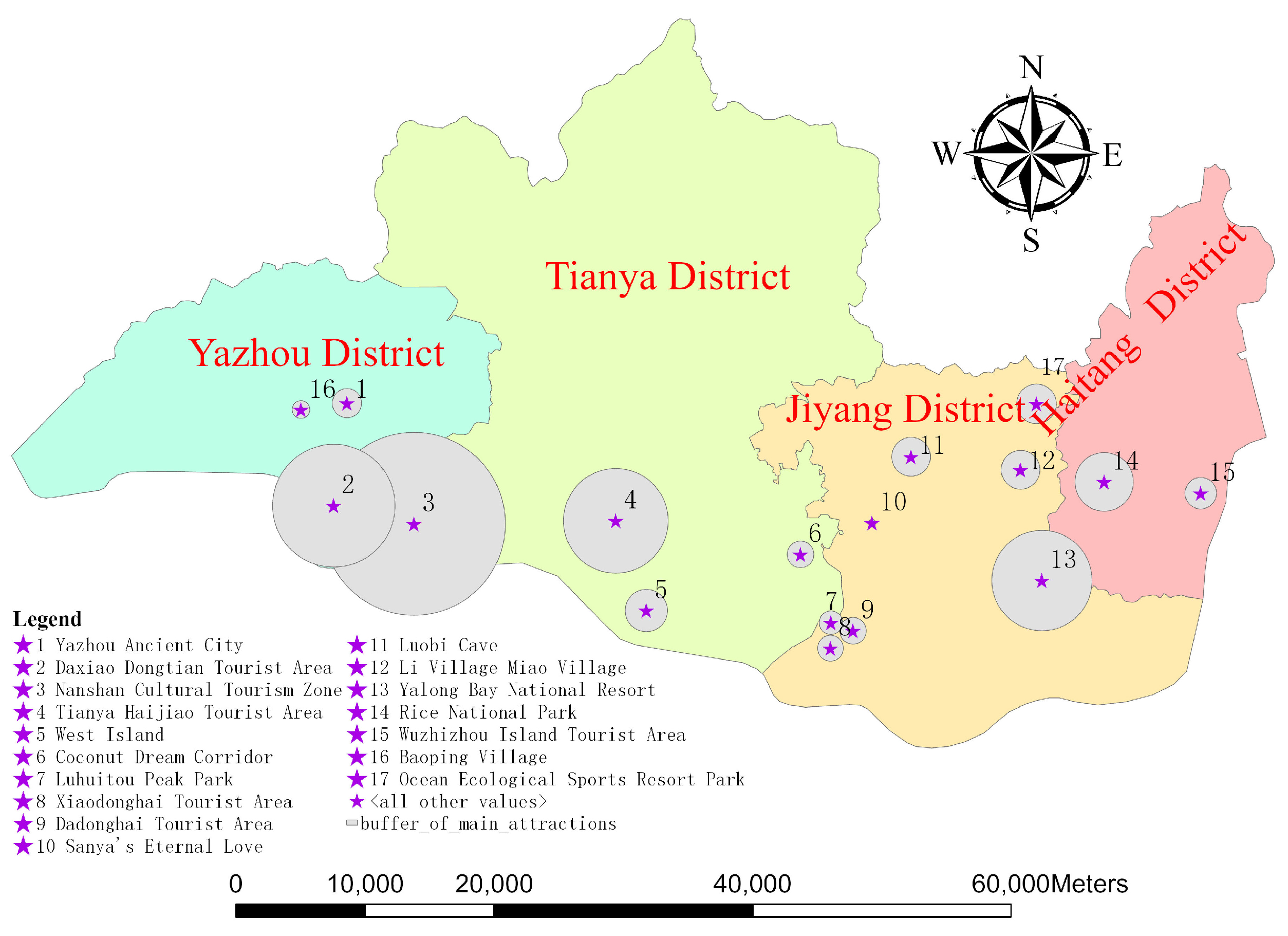

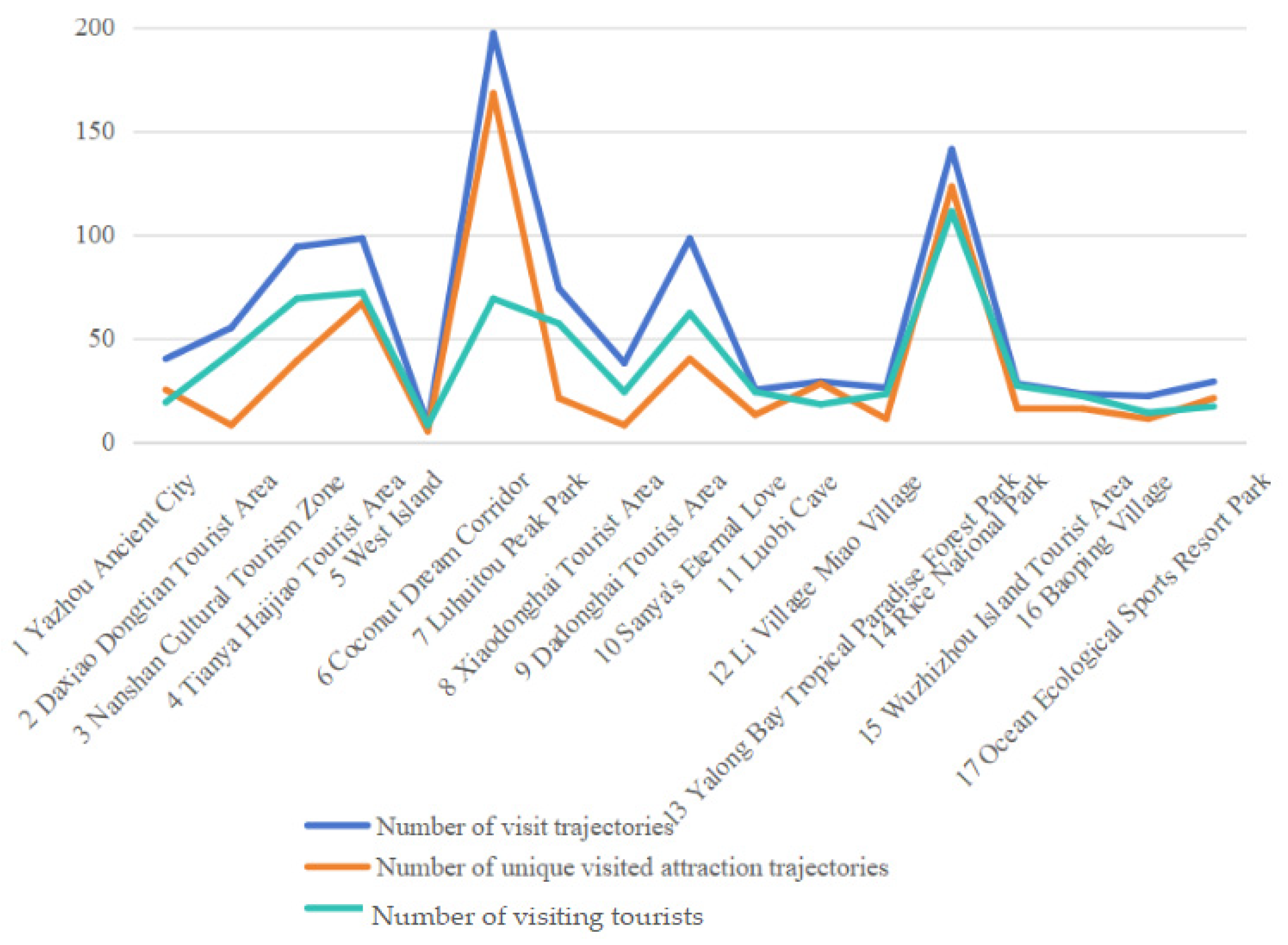

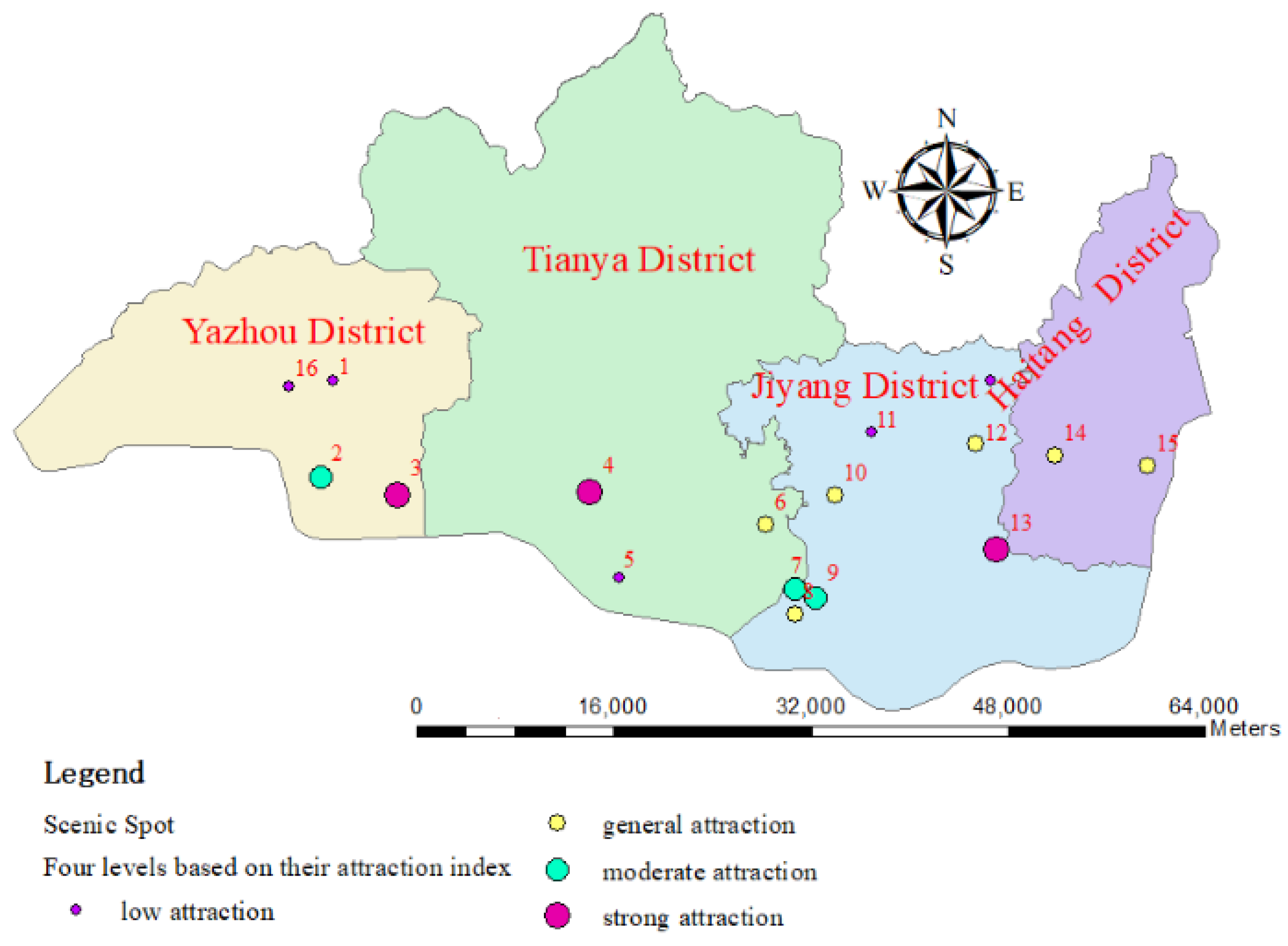
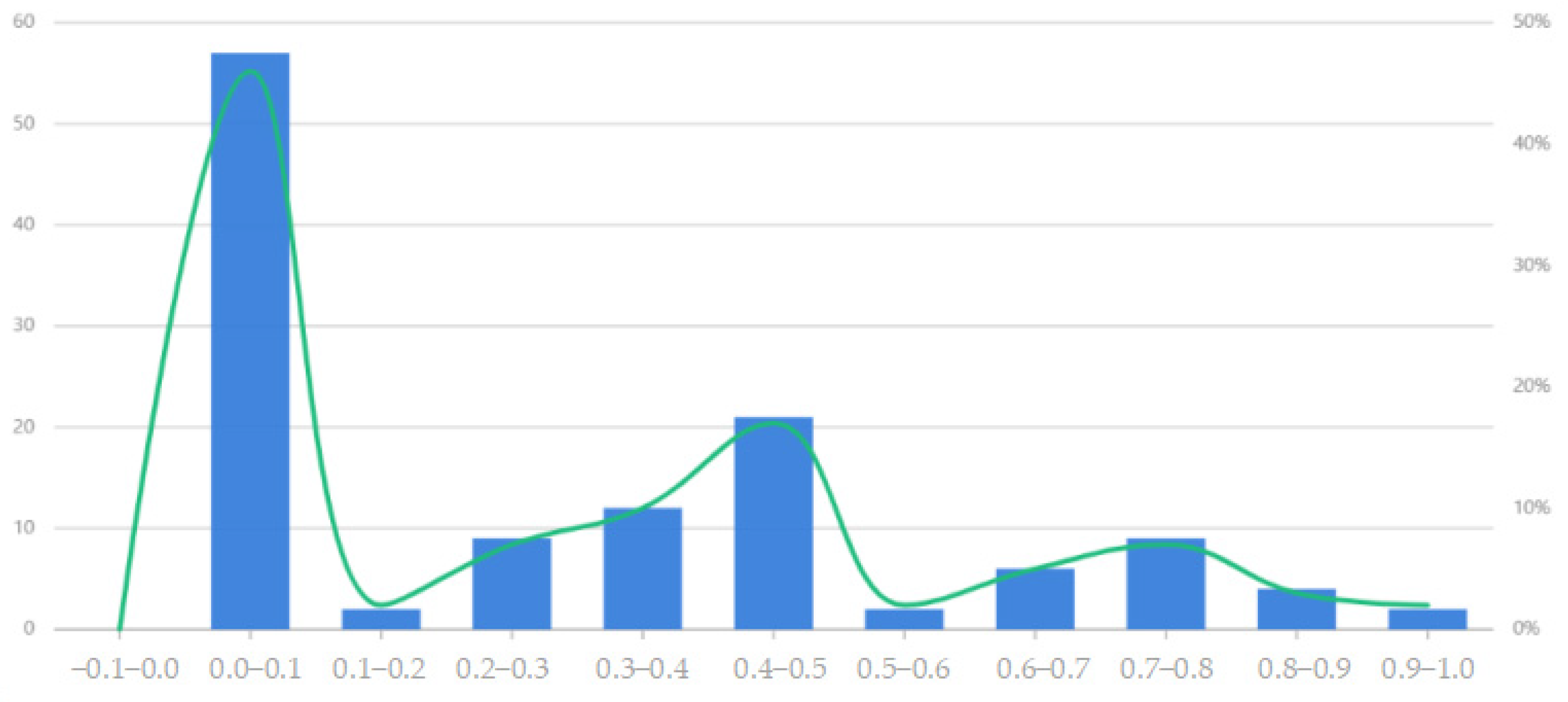
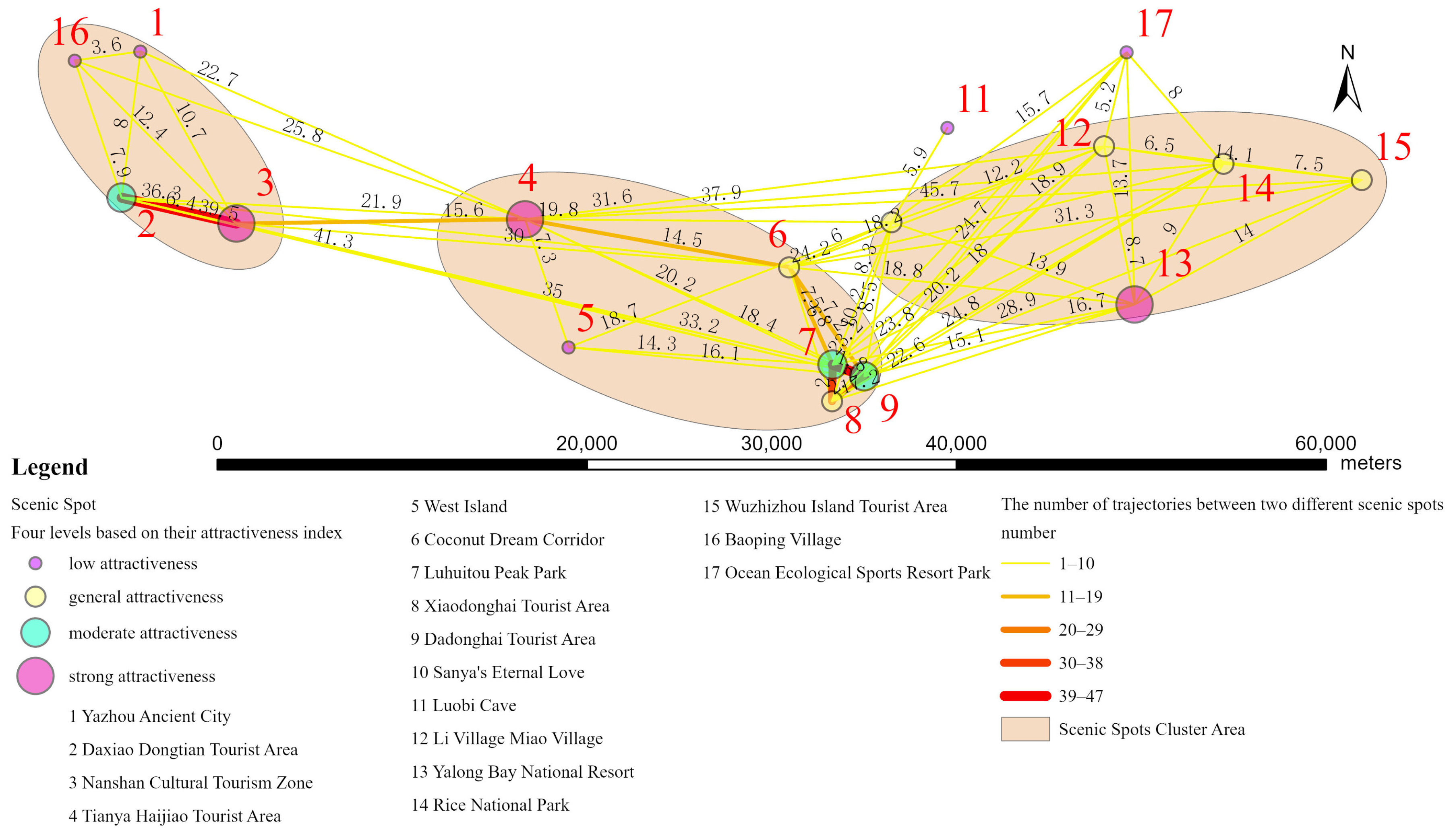
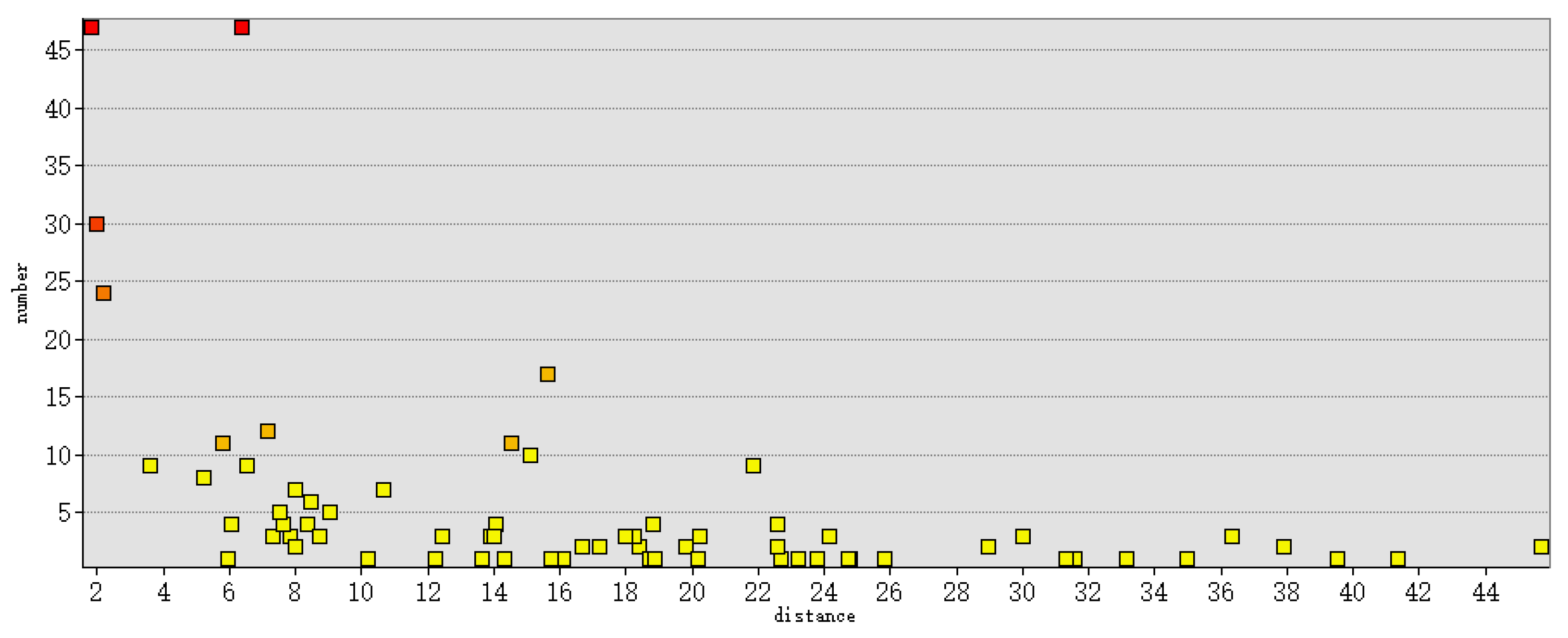
| Number of scenic spots (Sm) | 0 | 1 | 2 | 3 | 4 | 5 | 6 | 7 |
| Number of trajectories (NTrSm) | 775 | 620 | 95 | 44 | 15 | 2 | 1 | 1 |
| Concentration | Dispersion | Total (Proportion%) | ||
|---|---|---|---|---|
| Local tourists (67 people) | Non-scenic spot | 12 | 4 | 16 (24%) |
| Few scenic spots | 18 | 21 | 39 (58%) | |
| Multi scenic spots | 3 | 9 | 12 (18%) | |
| Total | 33 | 34 | 67 | |
| Visiting tourists (58 people) | Non-scenic spot | 11 | 1 | 12 (21%) |
| Few scenic spots | 21 | 16 | 37 (64%) | |
| Multi scenic spots | 1 | 8 | 9 (15%) | |
| Total | 33 | 25 | 58 |
| Number of Visits by Local Tourists | Number of Local Tourists | Average Number of Visits per Local Tourist | Number of Visits by Visiting Tourists | Number of Visiting Tourists | Average Number of Visits per Visiting Tourist | |
|---|---|---|---|---|---|---|
| 1 Yazhou Ancient City | 18 | 5 | 3.6 | 15 | 7 | 2.1 |
| 2 Daxiao Dongtian Tourist Area | 17 | 12 | 1.4 | 10 | 6 | 1.7 |
| 3 Nanshan Cultural Tourism Zone | 19 | 15 | 1.3 | 33 | 16 | 2.1 |
| 4 Tianya Haijiao Tourist Area | 26 | 15 | 1.7 | 27 | 16 | 1.7 |
| 5 West Island | 0 | 0 | 0.0 | 3 | 3 | 1.0 |
| 6 Coconut Dream Corridor | 34 | 12 | 2.8 | 24 | 11 | 2.2 |
| 7 Luhuitou Peak Park | 31 | 17 | 1.8 | 17 | 14 | 1.2 |
| 8 Xiaodonghai Tourist Area | 22 | 11 | 2.0 | 4 | 3 | 1.3 |
| 9 Dadonghai Tourist Area | 48 | 21 | 2.3 | 16 | 14 | 1.1 |
| 10 Sanya’s Eternal Love | 5 | 5 | 1.0 | 5 | 4 | 1.3 |
| 11 Luobi Cave | 20 | 9 | 2.2 | 1 | 1 | 1.0 |
| 12 Li Village Miao Village | 7 | 6 | 1.2 | 6 | 5 | 1.2 |
| 13 Yalong Bay Tropical Paradise Forest Park | 24 | 16 | 1.5 | 25 | 12 | 2.1 |
| 14 Rice National Park | 2 | 2 | 1.0 | 6 | 5 | 1.2 |
| 15 Wuzhizhou Island Tourist Area | 3 | 3 | 1.0 | 6 | 5 | 1.2 |
| 16 Baoping Village | 7 | 2 | 3.5 | 9 | 6 | 1.5 |
| 17 Ocean Ecological Sports Resort Park | 20 | 9 | 2.2 | 1 | 1 | 1.0 |
| Scenic Spot | Attraction Index | Ticket Price Unit: CNY (A-Level) | Types of Scenic Spots (1: Natural Landscape. 2: Cultural Heritage. 3: Leisure and Entertainment) |
|---|---|---|---|
| 5 West Island | 0.00 | 95 (4A) | 3 |
| 1 Yazhou Ancient City | 0.13 | 0 | 2 |
| 16 Baoping Village | 0.16 | 0 | 2 |
| 17 Ocean Ecological Sports Resort Park | 0.18 | 0 | 1 |
| 11 Luobi Cave | 0.22 | 0 | 1 |
| 6 Coconut Dream Corridor | 0.29 | 0 | 3 |
| 15 Wuzhizhou Island Tourist Area | 0.37 | 140 (5A) | 3 |
| 8 Xiaodonghai Tourist Area | 0.39 | 0 | 3 |
| 12 Li Village Miao Village | 0.40 | 0 | 2 |
| 10 Sanya’s Eternal Love | 0.43 | 280 | 2 |
| 14 Rice National Park | 0.48 | 30 (4A) | 1 |
| 2 Daxiao Dongtian Tourist Area | 0.63 | 0 (5A) | 1 |
| 9 Dadonghai Tourist Area | 0.73 | 0 (4A) | 3 |
| 7 Luhuitou Peak Park | 0.73 | 0 (4A) | 1 |
| 3 Nanshan Cultural Tourism Zone | 0.81 | 122 (5A) | 2 |
| 4 Tianya Haijiao Tourist Area | 0.83 | 0 (4A) | 3 |
| 13 Yalong Bay Tropical Paradise Forest Park | 1.00 | 148 (4A) | 1 |
| Experience Index Interval | Number of Tourists | Proportion (%) |
|---|---|---|
| 0–0.25 | 62 | 0.50 |
| 0.26–0.50 | 39 | 0.31 |
| 0.51–0.75 | 13 | 0.10 |
| 0.76–1 | 11 | 0.09 |
| Total (unit: person) | 125 | 1.00 |
Disclaimer/Publisher’s Note: The statements, opinions and data contained in all publications are solely those of the individual author(s) and contributor(s) and not of MDPI and/or the editor(s). MDPI and/or the editor(s) disclaim responsibility for any injury to people or property resulting from any ideas, methods, instructions or products referred to in the content. |
© 2024 by the authors. Licensee MDPI, Basel, Switzerland. This article is an open access article distributed under the terms and conditions of the Creative Commons Attribution (CC BY) license (https://creativecommons.org/licenses/by/4.0/).
Share and Cite
Huang, Q.; Xia, L.; Li, Q.; Xia, Y. Evaluating the Attraction of Scenic Spots Based on Tourism Trajectory Entropy. Entropy 2024, 26, 607. https://doi.org/10.3390/e26070607
Huang Q, Xia L, Li Q, Xia Y. Evaluating the Attraction of Scenic Spots Based on Tourism Trajectory Entropy. Entropy. 2024; 26(7):607. https://doi.org/10.3390/e26070607
Chicago/Turabian StyleHuang, Qiuhua, Linyuan Xia, Qianxia Li, and Yixiong Xia. 2024. "Evaluating the Attraction of Scenic Spots Based on Tourism Trajectory Entropy" Entropy 26, no. 7: 607. https://doi.org/10.3390/e26070607
APA StyleHuang, Q., Xia, L., Li, Q., & Xia, Y. (2024). Evaluating the Attraction of Scenic Spots Based on Tourism Trajectory Entropy. Entropy, 26(7), 607. https://doi.org/10.3390/e26070607







